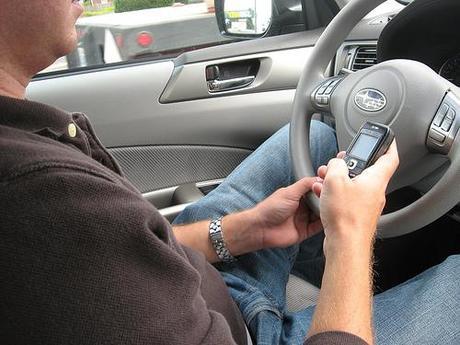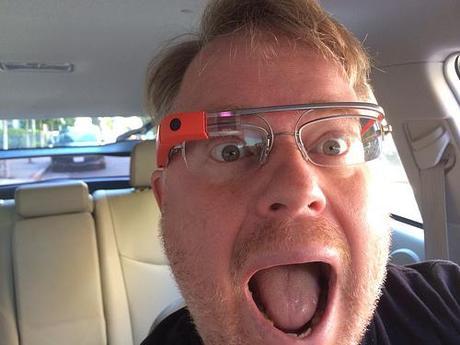You may have already seen someone wearing a futuristic (and funny-looking) eyewear accessory. Chances are it’s not a fashion statement from a leading designer—it’s Google Glass, the new wearable technology that brings a number of smartphone features from your pocket to eye level. Google expects this forward-thinking device to make an impact in the classroom, in the kitchen and yes, on the road.

Photo by giuseppe.costantino via Flickr
Some aren’t sold on the idea of Google Glass users behind the wheel, however. California resident and Glass user Cecilia Abadie posted a traffic ticket she got that cited wearing Glass while driving as an offense. Abadie asked those in her Google Plus circle if they could verify whether driving while wearing Glass was illegal. It turns out it is illegal under the letter of California law, which states that any video screens must display GPS information.
As the laws in many states stand, Glass will be prohibited behind the wheel. But what if this technology actually makes driving safer? That’s the claim from Google and a number of early users. The argument is simple: With Google Glass, drivers are less likely to reach for their phones, and therefore they are less likely to get into accidents. Garmin and other navigation providers already place on-windshield displays in driver views. Google Glass’ small display wouldn’t be more distracting that those screens. When you add it all up, roads will be safer with Google Glass users behind the wheel.
Google Glass vs. Smartphones
You’ve probably been there before: You’re late for a meeting or dinner, and your phone goes off. It’s a text message asking where you are, and you need to respond. The few seconds it takes to type out a reply can be catastrophic, though.Distraction.gov reports that the average text distracts drivers for 4.6 seconds. At 55 mph, it would be the equivalent of driving the length of a football field blind. With Google Glass, drivers may face similar distractions, but at least with Glass drivers don’t need to take their eyes off the road.

Photo by mrJasonWeaver via Flickr
Google is among those who believe that Glass can promote safety. In a prepared statement, a Google spokesman said, “We actually believe there is tremendous potential (with Glass) to improve safety on our roads and reduce accidents.” Time will tell whether Glass can actually improve driving performance, but if it’s between using Glass and using a smartphone, there’s no contest. Glass is safer.
First-Hand Accounts
Glass’ beta program, Glass Explorer, put the device in the hands of thousands of tech enthusiasts. Chris Barrett, a Glass Explorer, spent 1,500 miles behind the wheel with Google Glass, and his conclusion may surprise safety advocates. “I really feel that Google Glass will save lives,” Barrett told Cnet.com. He cited the display, which remained tightly in the corner of his visual field. If other Glass Explorers express a similar experience with the device, lawmakers may reconsider whether this wearable technology is really as dangerous as they think.

Photo by Robert Scobia via Flickr
Automakers and Google Glass
The use of emerging technologies by automakers is nothing new. Auto manufacturers have been using computers to enhance the driving experience for more than three decades now. One of the more intriguing questions around Glass and driving is how it will leverage existing vehicle computer technology. For instance, many newer cars already have computer sensors that relay information such as tire pressure and wear. In the future, Glass may be able to alert you when your car needs new tires and suggest a specific brand based on your driving habits.
Mercedes and Tesla are both anticipating that lawmakers will deem Glass safe behind the wheel. Both automakers are developing apps that integrate car functions into the device. Tesla for Glass enables users to charge their vehicles, get directions and lock their cars using voice commands.
A piece of electronic eyewear that helps people drive safer sounds like something out of science fiction, but it could be headed to a highway near you—and sooner than you think.
1 Flares Twitter 1 "> Facebook 0 Google+ 0 "> LinkedIn 0 "> StumbleUpon 0 "> Filament.io Made with Flare More Info"> 1 Flares ×- Bio
- Latest Posts

Ben Greenwood
Ben is the founder and editor of TechDrink. A huge fan of technology and social media, he has been blogging on those and many other subjects for well over five years. You can follow him in many places, including Twitter, Facebook and Google+.
Latest posts by Ben Greenwood (see all)
- Don’t Ban Glass Behind the Wheel: Google’s Eyewear Will Make for Safer Driving - November 18, 2013
- Start Accepting Mobile Payments and Maximize Your Revenue - November 6, 2013
- The Top Gadgets to Improve Productivity for Small Business Owners - November 4, 2013

